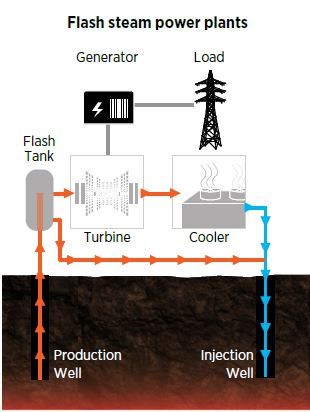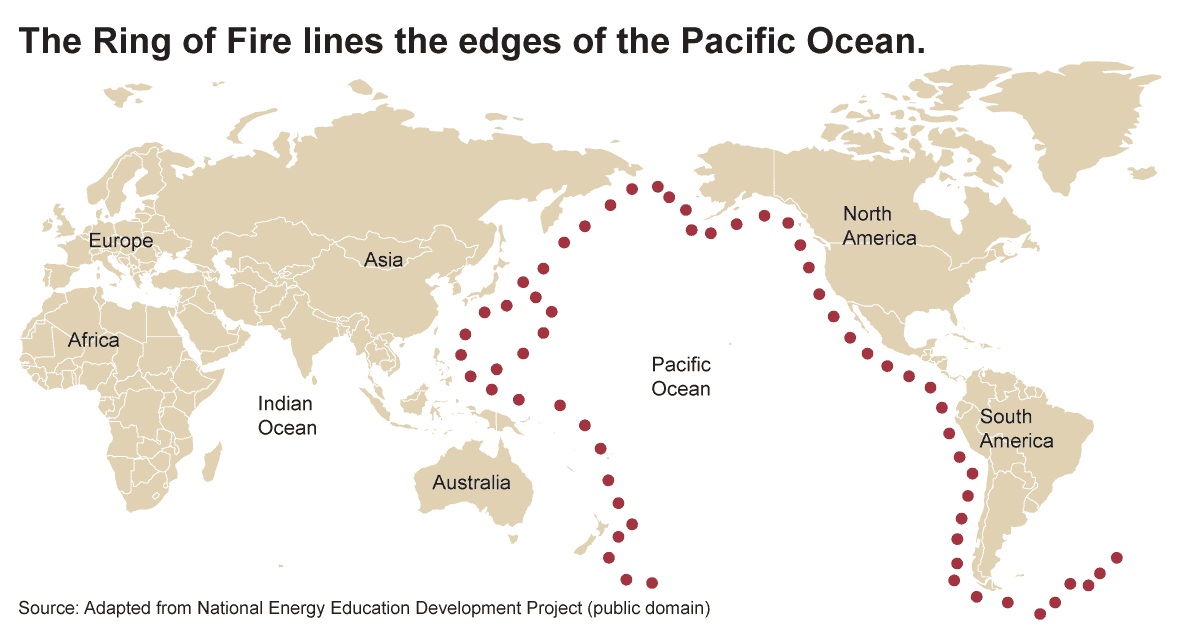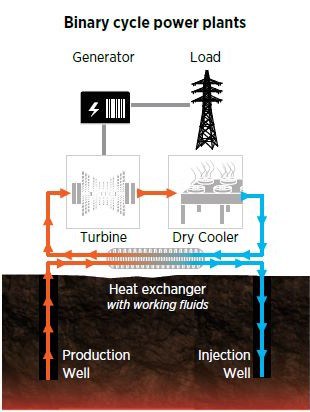High temperature geothermal systems are attractive for commercial development because they can be used to generate electricity. A geothermal resource requires fluid, heat, and permeability to generate electricity. Hydrothermal resources are considered conventional geothermal resources and contain all three components naturally. These geothermal systems can occur in widely diverse geologic settings, sometimes without clear surface manifestations of the underlying resource. In the United States, most high temperature geothermal resources are in the western states, primarily because of the favorable geologic and tectonic history in that area, which will be discussed later on this topic page.1U.S. Dept. of Energy, Energy Efficiency & Renewable Energy. (2016, April). Hydrothermal Fact Sheet. https://www.energy.gov/sites/default/files/2016/04/f30/Hydrothermal%20Fact%20Sheet_1.pdf

Making Electricity Using Geothermal Energy
There are three main types of geothermal power plant technologies: dry steam, flash steam, and binary cycle. The mechanism for converting the geothermal heat into electricity is part of the power plant design and generally depends on the state of the subsurface fluid (steam or water) and its temperature.
Let’s take a look at an introductory video from the U.S. Department of Energy that focuses on high temperature geothermal systems and power production.
Hydrothermal Systems
In high temperature hydrothermal systems, steam from geothermal wells can be used directly to turn a turbine (dry steam); or, as hot water arrives at the surface and cools, a vapor is produced that can be used to turn a turbine (flash steam). Both of these hydrothermal systems are used to produce electricity.2U.S. Dept. of Energy. (2019, May). GeoVision: Harnessing the Heat Beneath Our Feet. https://www.energy.gov/eere/geothermal/articles/geovision-full-report-0.


Where are Hydrothermal Systems Found?
Hydrothermal systems are the most established type of geothermal systems that have been in commercial operation for decades. Geology and location limit the availability and production of hydrothermal systems. Almost all hydrothermal systems are found in the Ring of Fire. The Ring of Fire is a string of volcanoes and seismically active sites starting at the southern tip of South America and circling along the coast of the western United States, Japan, Indonesia, and New Zealand.
The Ring of Fire is a result of plate tectonics. In this region, lithospheric plates (for example, the Pacific Plate) move and collide around the Pacific Ocean. The collisions have created a nearly continuous series of subduction zones characterized by deep oceanic trenches along the seafloor, with associated volcanoes and earthquakes. As magma rises to the earth’s surface as volcanic activity, the rising molten rock heats water trapped in porous rock or water running along fractured rock surfaces and faults. This plate tectonic scenario provides one of the most active geothermal areas in the world.

The Ring of Fire, outlined in the map above by red dots, is a result of plate tectonics. In this region, lithospheric plates (for example, the Pacific Plate) move and collide around the Pacific Ocean. The collisions have created a nearly continuous series of subduction zones characterized by deep oceanic trenches along the seafloor, with associated volcanoes and earthquakes. As magma rises to the earth’s surface as volcanic activity, the rising molten rock heats water trapped in porous rock or water running along fractured rock surfaces and faults. This plate tectonic scenario provides one of the most active geothermal areas in the world.
As illustrated below, the Pacific Ring of Fire is naturally delineated by this United States Geological Survey record of volcanic activity (yellow), along with earthquakes (red to green to blue with increasing depth) for over a century. Warm colors indicate earthquakes at shallower depths (red=<69 km deep within the earth), whereas cooler colors indicate deeper earthquakes (blue=300+ km deep within the earth). The size of the circles indicate the relative magnitudes of earthquakes. (Click map to enlarge.)
What continent is along the Ring of Fire?
Incorrect
Correct
Incorrect
Do a little geographic research and find out which of these countries is along the Ring of Fire?
Incorrect
Incorrect
Incorrect
Incorrect
Correct
Correct
Correct
Because of those countries location along the Ring of Fire, what might you predict about their capabilities to integrate geothermal energy into their country’s energy porfolio?
I would predict that geothermal energy resources would have a significant contribution to the energy portfolio of countries along the Ring of Fire.
Binary Systems
In a binary system geothermal water/steam can be used to heat a lower boiling point liquid to its gas phase and that pressure is then used to turn a turbine. A binary system is an indirect way of harvesting Earth’s heat for electricity production. The process begins with a geothermal fluid that arrives at the surface and then subsequently enters the geothermal power plant facilities. A common type of design for geothermal power plants is based on the binary organic Rankine cycle (ORC). In this thermodynamic cycle, the geothermal fluid heats the organic fluid. The organic fluid, also referred to as the working fluid, has a lower boiling point, so the fluid turns into a vapor through indirect contact in the heat exchanger. The organic vapor passes through a turbine to generate mechanical work, which is then converted to electricity, as shown in the diagram below. ORC technology often uses hydrocarbons as the appropriate working fluid.3U.S. Energy Information Administration (EIA). (2022, December 21). Geothermal Power Plants. EIA. https://www.eia.gov/energyexplained/geothermal/geothermal-power-plants.ph

Are binary systems a direct or indirect method of harnessing geothermal energy?
Incorrect
Correct
Image Credits
- Hydrothermal diagram: EERE, Hydrothermal Fact Sheet
- Dry-steam-plant-GeoVision-2.8: DOE, GeoVision
- Flash-steam-plant-GeoVision-2.8: DOE, GeoVision
- Ring-of-Fire-NEED: NEED via EIA
- Ring-of-Fire-USGS-Wikipedia-Large: USGS
- Binary-cycle-plant-GeoVision-2.8: DOE, GeoVision
